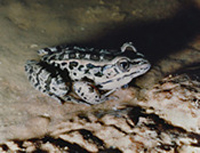at Onondaga Cave State Park
 |
|---|
You might get the impression that caves are beautiful, complex, fascinating and sterile. Sterile? Not on our living planet; caves are loaded with life. Perhaps not as much as on the surface, but approximately 60 different species have been found living in Onondaga Cave. These include: bats, frogs, salamanders, amphipods, snails and an occasional fish. The cave does, however, present special challenges to animal life. (What about plant life? Read on.)
Cave habitats can be divided into three zones:
The Twilight Zone
This is the area of cave that extends from the entrance to as far as unaided human vision is possible. There is some light. It is damp and cool, but temperature and humidity vary widely. Not surprisingly, this is the area that has the greatest abundance and diversity of life.
The Middle Zone
This area is just beyond the twilight zone. It has total darkness, but humidity and temperature do vary with daily and seasonal cycles.
The Zone of Total Darkness and Constant Temperature
This area has total darkness and the temperature typically fluctuates less than one degree over the course of a year*, about 14°C (57°F) for Onondaga Cave. The relative humidity is between 98% and 100%.
These zones can be further divided into terrestrial and aquatic microhabitats. The terrestrial (land) microhabitat is extremely diverse and is not easily affected by surface changes. The aquatic microhabitat can be further divided into streams and drip pools. Streams are usually connected to an outside food source and are easily affected by the surface changes. They have low pH (relatively), high dissolved oxygen, high content of organic food and much animal life. Drip pools have high pH, low dissolved oxygen, little food and few animals.
* A cave takes on the average annual temperature of the area in which it is located. All of the rock that surrounds the cave acts like a huge solar energy collector and storage unit, soaking up heat in the summer and releasing it in the winter, thus, keeping the cave close to the average yearly temperature of the area.






